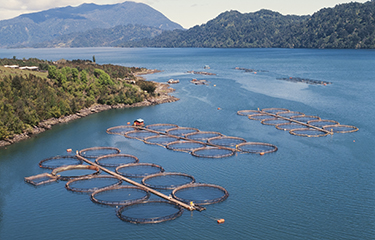Chilean trade body SalmonChile has published its latest sustainability report, highlighting record salmon production with a lighter ecological footprint compared to other sources of animal protein.
“Aquaculture is capable of generating the most-sustainable animal protein worldwide and has become the way to meet the fish and shellfish consumption needs of the growing world population," it said.
In 2020, more than one million metric tons [MT] of salmon were harvested in Chile, the country's highest value produced since 2007, the report said.
The report found farmed salmon production uses 13 times less water and its carbon footprint is 10 times less than that of livestock.
"These indicators make it one of the most sustainable proteins, so the biggest challenge for the salmon-farming sector is to maintain growth and production with sustainability standards that will meet the global demand for healthy foods," it said.
In 2020, SalmonChile's members had 94 percent of their total biomass for their three primary farmed species – Atlantic salmon, coho salmon, and rainbow trout – certified by to the standards of the Aquaculture Stewardship Council, GlobalG.A.P., or Best Aquaculture Practices programs, up from 83 percent of certified volume in 2019.
The report said Chile's salmon-farming sector has been working to improve its health indicators through innovation and the adoption of new technologies.
The industry reached an agreement reached with the Monterey Bay Aquarium in 2019 to reduce the use of antibiotics by 25 percent by 2050. Last year, the industry lowered its antibiotic use-rate to 298 grams-per-MT of biomass harvested, down from the 621 grams-per-MT it registered in 2016, and a 14.6 percent drop from the 349 grams-per-MT it used in 2019.
At the same time, the use of alternatives for non-medicinal treatments against sea lice increased substantially during 2020 compared to previous years, with its use being six and 11 times higher compared to 2016 and 2019, respectively. The use of antiparasitic treatments decreased 40 percent to 6.4 grams-per-MT in relation to 2019, the lowest indicator reported since 2013. Meanwhile, the average number of adult sea lice in fish remained stable, at an average number of three per fish.
The number of fish escape events increased from five in 2019 to eight in 2020, while the number of fish escaped increased nearly fourfold from 85,697 to 410,150. The mortality rate inched down 0.1 percentage points to 3.4 percent.
Chile has positioned its salmon-farming sector as a pillar in the national growth and export strategy, growing salmon to become the second-largest export behind copper. In 2020, Chile's salmon exports were worth USD 4.4 billion (EUR 3.8 billion), down 14.3 percent compared to 2019. The decrease has been attributed to the effects of the COVID-19 pandemic, which led to the near-total closure of the hotel, restaurant, and catering (HORECA) channel.
“Projections for the future suggest that the salmon-farming sector will continue to consolidate its position in traditional markets and will eventually open new ones," SalmonChile said. "The challenge is to continue contributing to food security, maintaining the activity’s decentralizing spirit of the and striving to make the operation compatible with the environment and the communities in which we operate."
The regions where the salmon industry operates are located in the southernmost part of Chile, away from Chile's economic and political power-base in the capital city of Santiago. However, unemployment figures in the Chilean Patagonia are below the national average, with the salmon-farming industry estimated to be responsible for more than 71,000 jobs, with 66 percent of the jobs concentrated in the Los Lagos Region. In recent years, the industry has focused on skills- and capacity-building, as well as education for employees and within communities, SalmonChile said, with its member companies providing more than 340,000 hours of job-training during 2020.
Chile's salmon-farming sector also contributes directly to municipal funds through its payments for aquaculture licenses, which are distributed equally between the central government and the regions where the aquaculture concessions are located.
“These are a concrete contribution to the decentralization of the country and a fundamental pillar to face the diverse social policies of the localities of the extreme south of Chile, since they allow the generation of projects with high local impact,” the trade body said.
In 2020, SalmonChile members paid CLP 11.2 billion (USD 13.8 million, EUR 11.9 million) for its licenses, down 23.8 percent when compared to the CLP 14.7 billion (USD 18.1 million, EUR 15.7 million) paid in 2019 and comparable to 2016 levels.
The sustainability report also highlighted the industry’s care for its workers, with a decrease of the industry's accident rate in 2020. Last year, the accident rate fell to 2.1 percent compared to 2019 and has remained below 3 percent since 2016, and is a marked decrease from the 6.1 percent registered in 2013.
The report also found that in 2020, SalmonChile companies invested a total of CLP 1.42 billion (USD 1.7 million, EUR 1.5 million) in research and development, with 40 percent of the associates having an R&D department or similarly related area dedicated to R&D activities.
SalmonChile, as part of the sustainability report, has generated individualized reports for each of its corporate members.
Photo courtesy of MARCELODLT/Shutterstock







